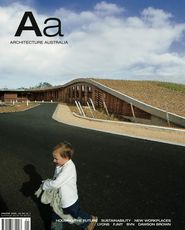THEORY
In discussions about theory (AA September/October 2004), statements which would otherwise be thought dubious or false can seem like novel or arresting truths. Mark Wigley says that “the role of the architect is not to make buildings, but to make discourse about buildings and to make buildings as a form of discourse”. If a chef said her role was not to prepare food but to write about it, or to prepare food only as a form of gastronomic conversation, many would be obliged or choose to eat elsewhere.
Beatriz Colomina says that for some time “architecture has been produced not simply on the building site” but in the media – in magazines, film and more recently in virtual space. This claim rests largely on equivocation for it turns out that what she means by “architecture” includes “paper architecture”. Drawings or words produced for the media or the reproduction of buildings or other works in the media can be partof a process that ends in a piece of architecture (on a building site somewhere).
But a magazine like Architecture Australia, for all its capacities, is not a site where architecture is produced, any more than the Medical Journal of Australia is a place where you can have your tonsils out.
Is all this just rhetorical excess? Perhaps.
But Wigley’s declaration that the architect’s role is really to make discourse, in various guises, and Colomina’s blurring of buildings with the representations of (possible or actual) buildings seem to owe something to that tendency in theory to give primacy to language, to the means of representation at the expense of what is represented.
This is not confined to architecture.
Scepticism about such things as neutrinos, or genes, for example, and how we could know about them, has been accompanied by an emphasis on “gene” as a construct of language, or perhaps society. The conclusion is then drawn that language stands between us and genes or that it constructs them. But discourse about genes? Biologists make that when they write up their “discoveries” for a journal like Nature. Representation and discourse are thus what is real or knowable, and so the focus of theoretical concern. My guess is that without such a focus the above mistakes or excesses would be less likely or more obvious.
GREG BAMFORD
LANGUAGE PLEASE
What a delight it is to read Philip Drew’s verb-rich letter ( Architecture Australia vol 93 no 1, Jan/Feb 2004). Even Richard Weller is readable in this issue (Letters, p. 86).
Unfortunately the same cannot be said for Professor Gevork Hartoonian (p. 68).
Examining only the second sentence of his fourth paragraph, I ask: is it feasible for a relationship to exist between civic architecture and early Aboriginal settlement?
In 2004? Is it possible for civic architecture to have a dialogue with early Aboriginal settlement? If either or both of these theoretical constructs can be contemplated, and especially if each is asking essentially the same question, is it really necessary or simply totally tautological to raise the spectre of a dialogical relationship? Finally, I am at a loss to know what it is that has lost its aura forever: Early Aboriginal settlement? Civic architecture and early Aboriginal settlement?
The dialogical relationship between civic architecture and early Aboriginal settlement?
The tectonic of earthwork and framework?
If the art of criticism in architecture is to be cultivated, all articles about architecture, whether descriptive or critical, need to be couched in comprehensible and meaningful language. Don Watson’s Death Sentence: The decay of public language (Random House, 2003) should be compulsory reading for all.
A more legible font size would also help.
SHIRLEY PIPITONE















